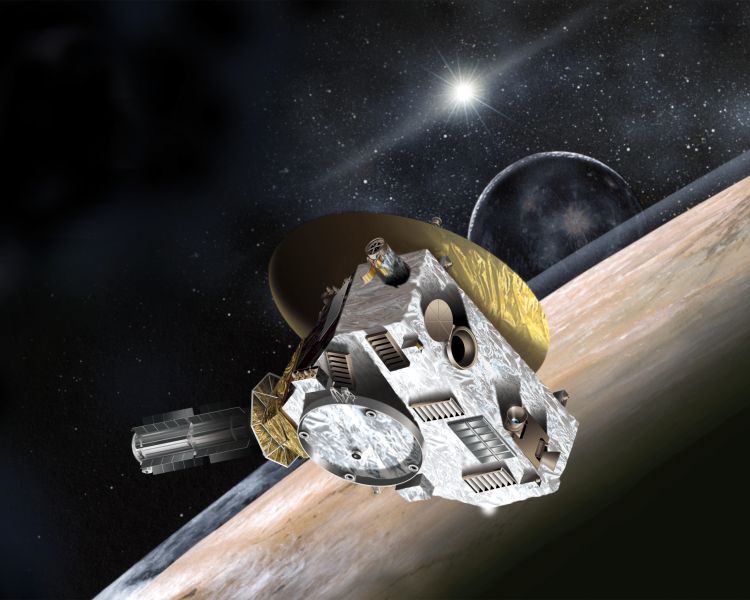
They say there’s no such thing in life as chance, but only choice. That certainly holds true for NASA’s New Horizons mission which has been the culmination of more than two decades of efforts by the space agency and the planetary science community alike to study the last unexplored frontier of the Solar System: dwarf planet Pluto and the vast expanses of the Kuiper Belt that lie beyond. Yet, in what can be described as a unique cosmic coincidence, New Horizons, which has been travelling through the outer Solar System for the last 8.5 years to reach its destination, has just passed the orbit of Neptune earlier this week, exactly a quarter-of-a-century after the iconic Voyager 2 spacecraft gave humanity its first close-up views of the fascinating ice giant planet, in August 1989. Having completed this major milestone, New Horizons is now in the homestretch of its historic journey toward Pluto, where it will arrive in less than a year, for its long-awaited flyby of this fascinating and mysterious world.
Staying true to the nature of its mythological namesake, Pluto is currently holding the keys to the Solar System’s gates of the unknown, beyond which lies a vast expanse that we know very little about. In large part due to its great distance from the Sun, which on average is approximately 5.8 billion km, Pluto is the only planetary body from the Solar System’s total real estate that has never been examined up close by any visiting spacecraft during the 50-year history of planetary exploration, thus essentially remaining remote and exotic, ever since it was discovered by American astronomer Clyde Tombaugh in 1930. Yet, with the discovery in the 1990s of a new region of minor icy planetary bodies beyond the orbit of Neptune, known as the Kuiper Belt, the interest among the planetary science community for Pluto, and the rest of the uncharted territory that laid beyond, was renewed. After a series of failed attempts during the 1990s to develop a dedicated science mission to explore these unknown frontiers of the Solar System due to budgetary constrains, namely with the Pluto Fast Flyby and Pluto Kuiper Express concepts, NASA finally earned the support of Congress for conducting a Pluto-dedicated mission, following a coordinated lobbying campaign by the planetary science community. It was out of this campaigning effort that the $650 million New Horizons mission arose, in 2001, being the first in the space agency’s New Frontiers-class of missions.
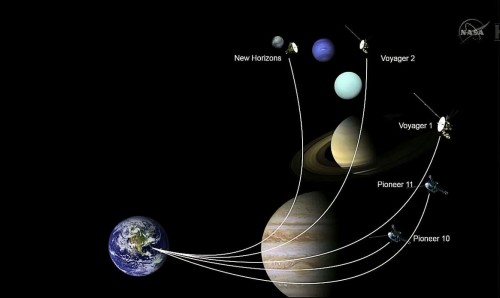
Launched in January 2006 onboard an Atlas V 551 rocket, New Horizons was sent with the help of a Star 48B third upper-stage into a hyperbolic, direct solar escape trajectory at a record speed of 36,373 mph (58,536 km/h), making it the fastest man-made object ever to leave Earth. This allowed the spacecraft to reach Jupiter just 13 months later, in February 2007, for a crucial gravity assist maneuver that would sling-shot it toward Pluto, allowing the mission’s team to conduct some important scientific observations of the giant gas planet, while also checking the overall health of New Horizon’s instruments in the process. Ever since the Jupiter flyby, the spacecraft—with the exception of a few brief periods of activity—has spent most of its time quietly passing the orbits of the outer planets en route toward its final destination. The latest major milestone on this journey occurred earlier this week when New Horizons passed the orbit of Neptune at 10:04 pm EDT on 25 August, marking the spacecraft’s last orbital crossing prior to its entrance into the realm of the planetary underworld early next year. Incidentally, this milestone occurred 25 years to the day after Voyager 2 had conducted its close flyby of Neptune, in August 1989, which was detailed in a recent history series by AmericaSpace writer Ben Evans. Yet, while for Voyager 2 this flyby marked the final chapter of an epic, decade-long journey of outer Solar System planetary exploration, New Horizons’ crossing of Neptune’s orbit represents only the beginning of humanity’s exciting and historic first foray into the unknown territory of the Kuiper Belt. “It’s a cosmic coincidence that connects one of NASA’s iconic past outer solar system explorers, with our next outer solar system explorer,” said Dr. Jim Green, director of NASA’s Planetary Science Division, during a two-part science briefing held at the space agency’s Headquarters in Washington, D.C., for the celebration of this historical milestone. “Exactly 25 years ago at Neptune, Voyager 2 delivered our ‘first’ look at an unexplored planet. Now it will be New Horizons’ turn to reveal the unexplored Pluto and its moons in stunning detail next summer on its way into the vast outer reaches of the Solar System.”
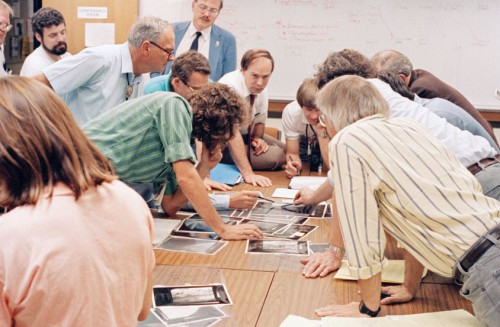
The science briefing, which was open to the media and the public and was broadcast live on NASA TV, also commemorated the 25th anniversary of the Voyager 2 Neptune Encounter, where senior members of the New Horizons mission team who had also worked on the Voyager missions shared their recollections of the excitement, awe, and wonder they felt during those heady days in August 1989. “Flybys are very intense, particularly if it is the first time you’ve been to that place,” said Dr. John Spencer, an Institute Scientist at Southwest Research Institute’s Department of Space Studies in Boulder, Colo. “You don’t know what to expect, you’re trying to imagine but you can’t possibly imagine what you’re going to see. And it all happens so fast and you’re just blown away and you’re short of dizzy for a long time afterwards.”
“Being a young scientist at the Jet Propulsion Laboratory during a Voyager encounter with one of the planets of the outer Solar System, now that was a party and a mind-blowing experience!” added Dr. David Grinspoon, a senior scientist at the Planetary Science Institute in Yuscon, AZ. “One that is just unforgettable and has stuck with and changed all of us who had the good fortune of being part of that.”
One of the great surprises of the Voyager 2 Neptune flyby was Triton, the largest moon of the distant ice giant planet, which has a diameter of 2,700 km. Even though it has one of the coldest surfaces ever measured in the entire Solar System (just 38 Kelvin above absolute zero), Triton was found to be a geologically active world, despite its great distance of 4.5 billion km from the Sun. When Voyager 2 flew over the moon’s northern hemisphere a day after the Neptune encounter, it transmitted back to the unsuspecting scientists on Earth images of geyser-like eruptions of gaseous nitrogen coming from its surface, which formed plumes up to 8 km high into Triton’s tenuous atmosphere. “The Voyager 2 flyby of Neptune was just another example of the surprises we had time after time as Voyager was flying by each of the outer planets,” commented Dr. Ed Stone, project scientist for the Voyager mission at the California Institute of Technology in Pasadena, during one of the commemorative science briefings on August 25 at the NASA Headquarters. “The Triton flyby was my favorite moment partly because it was a bookend. The journey really started with the discovery of volcanoes on Io with Voyager 1, ten years earlier – the first bookend. We finished the planetary part of the mission with another bookend, the flyby of Triton, where we discovered a much colder, smaller world that was also geologically active.”
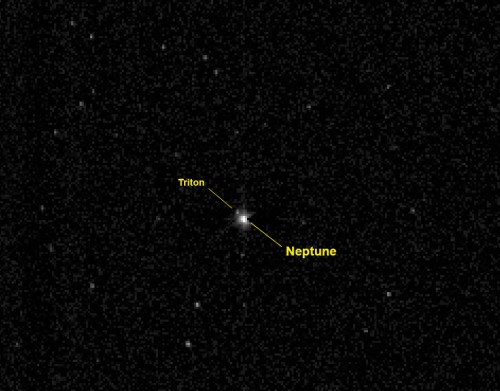
Could a similar geologic activity also be found on Pluto? Images taken with the Hubble Space Telescope have uncovered considerable brightness variations on this small world’s surface, while spectroscopic analysis of its thin atmosphere has shown that it is composed of gases like nitrogen, carbon monoxide, carbon dioxide, and methane, which sublimate from the ices present on the surface, constantly replenishing the dwarf planet’s atmosphere. More interestingly, as reported in a previous AmericaSpace article, recent studies have hinted at the possibility of Pluto sharing its atmosphere with the largest of its moons, Charon, which if confirmed would be a unique phenomenon never before seen elsewhere in the Solar System. All this indicates Pluto could be a geologically active body, not unlike Triton, replete with cryo-volcanic activity on its surface, possibly stemming from an underground ocean of liquid water. “There is a lot of speculation over whether Pluto will look like Triton, and how well they’ll match up,” said Dr. Ralph McNutt, Jr, Project Scientist for NASA’s MESSENGER mission at The Johns Hopkins University Applied Physics Laboratory, Laurel, Md. “That’s the great thing about first-time encounters like this – we don’t know exactly what we’ll see, but we know from decades of experience in first-time exploration of new planets that we will be very surprised.”
All this speculation will be replaced with hard facts in less than a year, when New Horizons will fly through the Plutonian system on 14 July 2015, giving us our first detailed, close-up views of the Solar System’s last unexplored planet. This will be accomplished with the help of the spacecraft’s onboard scientific payload, which consists of seven instruments:
— Ralph: A visible and infrared imager/spectrometer suite consisting of an optical panchromatic and color imager called the Multispectral Visible Imaging Camera, or MVIC, and an infrared imaging spectrometer called the Linear Etalon Imaging Spectral Array, or LEISA; provides color, composition, and thermal maps.
— Alice: An ultraviolet imaging spectrometer; analyzes composition and structure of Pluto’s atmosphere and looks for atmospheres around Charon and Kuiper Belt Objects (KBOs).
— REX: (Radio Science EXperiment) Measures atmospheric composition and temperature; passive radiometer.
— LORRI: (Long Range Reconnaissance Imager) telescopic camera; obtains encounter data at long distances, maps Pluto’s farside, and provides high-resolution geologic data.
— SWAP: (Solar Wind Around Pluto) Solar wind and plasma spectrometer; measures atmospheric “escape rate” and observes Pluto’s interaction with solar wind.
— PEPSSI: (Pluto Energetic Particle Spectrometer Science Investigation) Energetic particle spectrometer; measures the composition and density of plasma (ions) escaping from Pluto’s atmosphere.
— SDC: (Student Dust Counter) Built and operated by students; measures the space dust peppering New Horizons during its voyage across the Solar System.
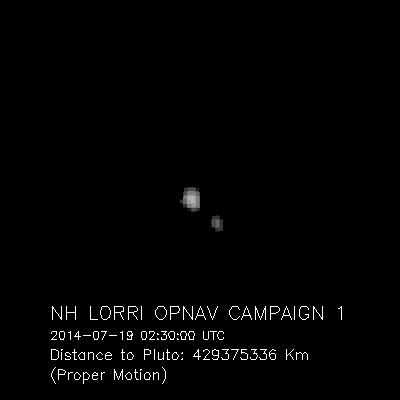
In order to ensure that the upcoming Pluto flyby will unfold as planned, the mission’s science team brought New Horizons out of hibernation on 15 June for the eighth and final annual checkout operations of its entire suite of science instruments and onboard back up systems. “This summer is ACO-8, our eighth annual checkout since launch,” writes Kimberly Ennico, a research astrophysicist at NASA’s Ames Research Center at Moffett Field, Calif., and deputy project scientist for New Horizons at the mission’s website. “It showcases our last calibrations prior to the 2015 Pluto encounter. It’s jam-packed with observations that are done yearly for trending, but also some new ones to make sure the New Horizons instrument suite is indeed ‘well-calibrated.’ Highlights include new radiometric calibrations for the LEISA infrared spectrometer, a long stability test for the REX radio experiment, and a test for revised thresholds for PEPSSI, the high-energy particle detector.” Other activities of this latest wake-up period included an 88-second course correction manuever, conducted on 14 July, the sixth overall since New Horizon’s launch in 2006, which gave the spacecraft a small speed boost of 2.4 mph while keeping it on the right track for its rendezvous with Pluto next year. In addition, New Horizons used its onboard LORRI camera to take a series of 12 images of both Pluto and its largest moon, Charon, during mid-July, from a mean distance of 265 million miles away, as part of an optical navigation campaign that will help mission controllers on the ground to get a better fix on Pluto’s exact position in the sky, allowing them to better plan for next year’s encounter operations.
The only remaining major issue regarding New Horizon’s mission is the lack of any suitable Kuiper Belt Objects for the spacecraft to visit, following the Pluto encounter. An optical survey of the vicinity of Pluto with the Hubble Space Telescope, which has been ongoing since June, was able to detect two such candidate objects; yet additional observations are required before it can be established that their orbits are within New Horizons fuel reach. Despite the uncertainty the mission’s science team remains optimistic that the superior observing capabilities of the Hubble telescope will eventually spot the right object in the Kuiper Belt, thus ensuring that New Horizons will have an extended science phase beyond Pluto.
Having just passed the last planetary orbit on its way to the mysterious and fascinating Pluto that lies at the very edge of the known Solar System, New Horizons is finally at the last leg of its journey, marking the end of its long, multi-year cruise through interplanetary space. Following the legacy of the legendary Voyager missions, New Horizons now awaits its turn to write the next great chapter in humanity’s ongoing exploration of space. “NASA’s Voyager 1 and 2 explored the entire middle zone of the Solar System where the giant planets orbit,” said Dr. Alan Stern, principal investigator for New Horizons at the Southwest Research Institute in Boulder, Colo. “Now we stand on Voyager’s broad shoulders to explore the even more distant and mysterious Pluto system. No country except the United States has the demonstrated capability to explore so far away. The U.S. has led the exploration of the planets and space to a degree no other nation has, and continues to do so with New Horizons. We’re incredibly proud that New Horizons represents the nation again as NASA breaks records with its newest, farthest and very capable planetary exploration spacecraft.”
No one knows what new marvels await us on Pluto, but if the results of the Voyager flybys are any indication, we will be in for a real treat when New Horizons swings by the mystifying dwarf planet on 14 July 2015.
Video Credit: NASA
Want to keep up-to-date with all things space? Be sure to “Like” AmericaSpace on Facebook and follow us on Twitter: @AmericaSpace
Missions » New Horizons »



The New Horizon mission will be a significant achievement in planetary exploration. The technology and precision of the spacecraft is testimony to the dedication and hard work of the mission planners, scientists and others involved in the project. Again, I say, full speed ahead with other missions to the Jupiter/Saturn moons.
Great article, Leonidas!
I can’t wait for New Horizons to reach Pluto in less than a year! But given that it took a quarter of a century from the proposal of a “fast Pluto” mission until one finally reaches Pluto, it probably isn’t too early to start thinking about a follow on to New Horizons.
http://www.drewexmachina.com/2014/07/14/the-next-mission-to-pluto/